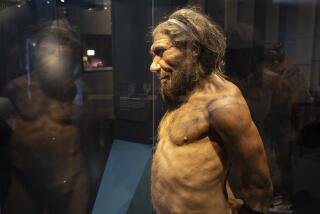We Are the World
- Share via
Humans are pattern-seeking, storytelling animals. We look for and find patterns in our world and in our lives, then weave narratives around those patterns to bring them to life and give them meaning. Such is the stuff of which myth, religion, history and science are made.
Sometimes the patterns we find represent reality--DNA as the basis of heredity or the fossil record as the history of life, for example. But sometimes the patterns are imposed by our minds rather than discovered by them: An eroded Martian mountain looks to us like a face, or an oil stain resembles the Virgin Mary. The rub lies in distinguishing which patterns are true and which are false, and the essential tension (as Thomas Kuhn called it) pits skepticism against credulity as we try to decide which patterns should be rejected and which should be embraced.
That tension is at the forefront of Robert Wright’s latest work, “Nonzero: The Logic of Human Destiny.” An experienced journalist, Wright is a formidable thinker and a persuasive writer on scientific matters. In the introduction, he proclaims that just as Francis H.C. Crick and James D. Watson announced that the double helix was “the secret of life,” “I would like to nominate another candidate”--nonzero.
In zero-sum games like tennis, he goes on to explain, the margin of victory for one player is the margin of defeat for the other. If I win 6-2, you lose 2-6; my margin of victory was plus-four, your margin of defeat was minus-four, adding up to zero. In nonzero-sum games, it can be argued that both players win, as in an economic exchange in which I win by purchasing your product and you win by receiving my money.
What Wright proposes is that over billions of years of natural history and thousands of years of human history, there has been an increasing tendency toward the playing of nonzero games between organisms that allows more nonzero gamers to survive. That is, while competition between individuals and groups was common in both biological evolution and cultural history, symbiosis among organisms and cooperation among people have gradually displaced competition as the dominant form of interaction. Why? Because those who cooperated--who played more nonzero games--were more likely to survive and pass on their genes for cooperative behavior. “Nonzero sumness,” according to Wright, is a grand theory that explains just about everything, “from the primordial soup to the World Wide Web.”
As soon as life arose out of that bubbling primeval sludge, this trend toward “nonzero-sumness” began. The earliest cellular organisms, the prokaryote cells, gathered together in a cooperative venture to survive in a hostile environment. Thus they became eukaryote cells, the complex units of which we are made (those little cellular organelles you had to memorize in high school biology were once autonomous cells back in the Precambrian). Single eukaryote cells then clumped together into multicellular organisms, which then invented the delightful nonzero game of sex that accelerated genetic variability from which natural selection could select. These multicellular sexually reproductive organisms then discovered that they were better able to survive by playing other nonzero games such as kin selection and reciprocal altruism.
In kin selection, we act unselfishly toward our genetic kin (children, brothers and sisters, cousins) because, in the long run and on average, more of our genes will make it to the next generation than if we act only selfishly in a zero-sum fashion. In reciprocal altruism (“I’ll scratch your back if you’ll scratch mine”), we cooperate because, as one saying goes from the American Revolution, “if we don’t hang together we’ll all hang separately.” Social animals such as ants and humans are especially good at nonzero games; not coincidentally, ants and humans abound.
It is important to realize that animals are not aware they are being altruistic in any conscious goodwill sense. All animals, including human animals, are just trying to survive, and it turns out that cooperation is a good strategy, as Wright notes about bats: “A vampire bat, on returning from a nightly blood-sucking expedition empty-handed, may accept a donation of regurgitated blood from a close friend--and will return the favor on some future night when fortunes are reversed. Both bats benefit in the long run. Of course, they aren’t smart enough to recognize this win-win dynamic. Still, it is nonzero-sum logic that natural selection followed in programming bats to behave as if they did understand such things.”
Humans have followed a similar course. From the Paleolithic age to today, human groups have evolved from bands, to tribes, to chiefdoms, to states and nations. Wright argues that this could not have happened without cooperative nonzero exchanges. The hallmarks of humanity--language, tools, hunting, gathering, farming, writing, art, music and even the World Wide Web--evolved through our willingness to work with one another. Humans are, by nature, nonzero animals.
As grand as his narrative of history is, Wright makes another point that’s even more extraordinary. Nonzero-sumness has influenced our biological and cultural evolution, which, Wright argues, gives meaning to life. “[T]he evolutionary process,” he writes, “is subordinate to a larger purpose--a ‘higher’ purpose, you might even say.” At this point Wright enters an interesting debate within evolutionary science: Was our existence necessary and inevitable or contingent and unlikely? Wright believes it is the former. Rewind the tape of life and play it back over and over and we would appear again and again. By “we” he means an intelligent social species that carries its “social organization to planetary breadth.” If humans had not filled this inevitable position of global dominance, one of the other hominids--the Neanderthals, for example--or the great apes would have. This directionality or “purposefulness,” as Wright calls it, was built into the cosmos not by any higher intelligence, in a theological sense, but by the laws of nature.
*
How far back does Wright go for this global inevitability? All the way. “Globalization,” he writes, “has been in the cards not just since the invention of the telegraph or the steamship, or even the written word or the wheel, but since the invention of life. All along, the relentless logic of nonzero-sumness has been pointing toward this age in which relations among nations are growing more nonzero-sum year by year.” Can a one-world government be far away? It is inevitable, says Wright. Pat Buchanan is bucking billions of years of evolution.
“Nonzero” is dressed up in the language of science, and Wright purports to be describing the world as it is. But his book is prescriptive, not descriptive. It presents a vision of the way the world should be (his discussion of cooperation and consensus seems especially suited for the political arena). The sentiments are warm (who would disagree with the promotion of more cooperation?), but science deals in facts, not sentimentality.
Is there really, as Wright suggests, a pattern of increase and dominance of nonzero exchanges in the evolution of life and culture? He offers no trend line graphs or comprehensive data sets that compare the changing rate of zero-sum and nonzero-sum exchanges. He never attempts to test his hypothesis. Instead, he just piles on examples that support his thesis and hopes that the reader does not find contradictory examples. In reality, the evidence overwhelmingly indicates that zero-sum encounters in nature are common, brutal and a driving force of evolutionary change that show no sign of abating. Human history is even worse, right up to the present, in which, for example, since the end of the Cold War, tribalism and genocide have become daily news stories. It is surprising that a savvy social commentator like Wright would ignore such zero-sum problems as Bosnia, Chechnya or East Timor. Stand on the border between India and Pakistan and tell the people there that nonzero-sumness is blossoming and cooperation is flowering.
Likewise, is social globalization an inevitable necessity of the evolutionary process? The scientific evidence indicates just the opposite. Paleoanthropologist Richard Klein’s authoritative work “The Human Career” shows that Neanderthals had brains as big as ours and were in Europe for 200,000 years, yet their tools and culture show almost no sign of change, let alone progress toward social globalization. And when modern humans arrived in Europe 42,000 years ago, they drove the Neanderthals into extinction in a thoroughly nonzero way. Wright claims that had it not been humans or Neanderthals, then one of the great apes or monkeys would have triumphed. But apes have never shown any inclination toward progressive cultural evolution, now or in the fossil record. And monkeys proliferated throughout Asia and the New World for tens of millions of years without any interference from hominids, yet they didn’t take one step toward developing a global culture. Humans are a contingent fluke, not a necessary triumph.
Wright has fallen into the oldest trap of all pattern-seeking, storytelling animals: writing yourself into the story as the central pattern in order to find purpose and meaning in this gloriously contingent cosmos. Wright’s thesis makes him, ironically, something of an accidental creationist. Despite all the ego-shattering discoveries of science that have shown time and again that there is nothing special about our place in the cosmos or in evolution, he believes that through nonzero-sumness the universe would inevitably give rise to us and that, if we continue to apply the nonzero process, as a bonus we can end war, poverty and ethnic cleansing: “Life on Earth was, from the beginning, a machine for generating meaning and then deepening it, a machine that created the potential for good and began to fulfill it. And, though the machine also created the potential for bad--and did plenty of fulfilling on that front--it now finally shows signs of raising the ratio of good to bad.” Chicken soup for the evolutionist’s soul!


